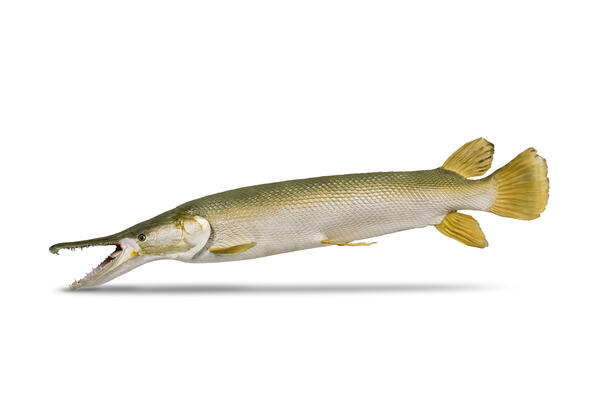The Mississippi Alligator gar is a member of the Actinopterygii class (also known as ray-finned fishes), the order of Lepisosteiformes of the Lepisosteidae family. This fish appeared about 100 million years ago and are often referred to as living fossils.
Modern Alligator gars (Atractosteus spatula) inhabit North and Central America. They are mainly found in the lower Mississippi River, closer to the Gulf of Mexico. These fish prefer to live in standing waters or in backwaters of large rivers with salt water. In the state of Louisiana, they are often found in salt marshes.
The Mississippi Alligator gar is the largest of the modern gar species. It reaches up to 4.5 meters in length and the torso girth can be about one meter. The jaws are much longer than in other species and can grow up to 45 centimeters; their appearance resembles that of an alligator.
The Alligator gar gets its name because its body is covered with tough scales, similar to an armorlike shell. It consists of two layers: an internal layer, which has a bony structure, and an external ganoine layer, a substance similar in composition to dental enamel. It gives the scales extra durability, smoothness, and shine. The dorsal and anal fins of the Alligator gar, like in all other pikes, are positioned toward the back of their bodies, closer to the tail.
Over the past 100 million years, the appearance of the Alligator Gar has not changed much, so scientists can easily identify what their ancient ancestors looked like. These living fossils have an unusual swim bladder, which contains blood vessels and is connected to their fore gut. Because of these features, the swim bladder can function as a lung; it means that when they break the surface, they can gulp air, which enters the bladder and then spreads through the blood vessels. This peculiarity allows them to inhabit bodies of water in which the oxygen level is quite low.
Alligator gars eat fish, mollusks, and crustaceans. Because of their large size, they are slow and unable to swim fast. Therefore, they prefer to ambush or drift slowly downstream until they find a suitable prey. Then they catch it by lunging forward, which does not require much effort.
Modern Alligator gars (Atractosteus spatula) inhabit North and Central America. They are mainly found in the lower Mississippi River, closer to the Gulf of Mexico. These fish prefer to live in standing waters or in backwaters of large rivers with salt water. In the state of Louisiana, they are often found in salt marshes.
The Mississippi Alligator gar is the largest of the modern gar species. It reaches up to 4.5 meters in length and the torso girth can be about one meter. The jaws are much longer than in other species and can grow up to 45 centimeters; their appearance resembles that of an alligator.
The Alligator gar gets its name because its body is covered with tough scales, similar to an armorlike shell. It consists of two layers: an internal layer, which has a bony structure, and an external ganoine layer, a substance similar in composition to dental enamel. It gives the scales extra durability, smoothness, and shine. The dorsal and anal fins of the Alligator gar, like in all other pikes, are positioned toward the back of their bodies, closer to the tail.
Over the past 100 million years, the appearance of the Alligator Gar has not changed much, so scientists can easily identify what their ancient ancestors looked like. These living fossils have an unusual swim bladder, which contains blood vessels and is connected to their fore gut. Because of these features, the swim bladder can function as a lung; it means that when they break the surface, they can gulp air, which enters the bladder and then spreads through the blood vessels. This peculiarity allows them to inhabit bodies of water in which the oxygen level is quite low.
Alligator gars eat fish, mollusks, and crustaceans. Because of their large size, they are slow and unable to swim fast. Therefore, they prefer to ambush or drift slowly downstream until they find a suitable prey. Then they catch it by lunging forward, which does not require much effort.



